
150 years of the German Hop Growers' Association – if you will
The roots of today’s advocacy group
By Christoph Pinzl
On February 21, 1874, the time had come. An illustrious group of gentlemen met in Nuremberg and founded the „Deutscher Hopfenbau-Verein“ (German Hop-Growing Association). The founding location could still be justified. Although no hops grew in Nuremberg, they did in the surrounding area. At that time, three quarters of Middle Franconia was planted with hops. The most important German hop-growing regions were located around Spalt, Hersbruck and Neustadt an der Aisch. However, a glance at the list of members was enough to cast doubt on whether this was really a representative body for all German hop farmers. There were a large number of large landowners, administrative officials, agricultural teachers, newspaper publishers and hop merchants, but how many ordinary farmers? Hardly any from the Hallertau region. Why was that?
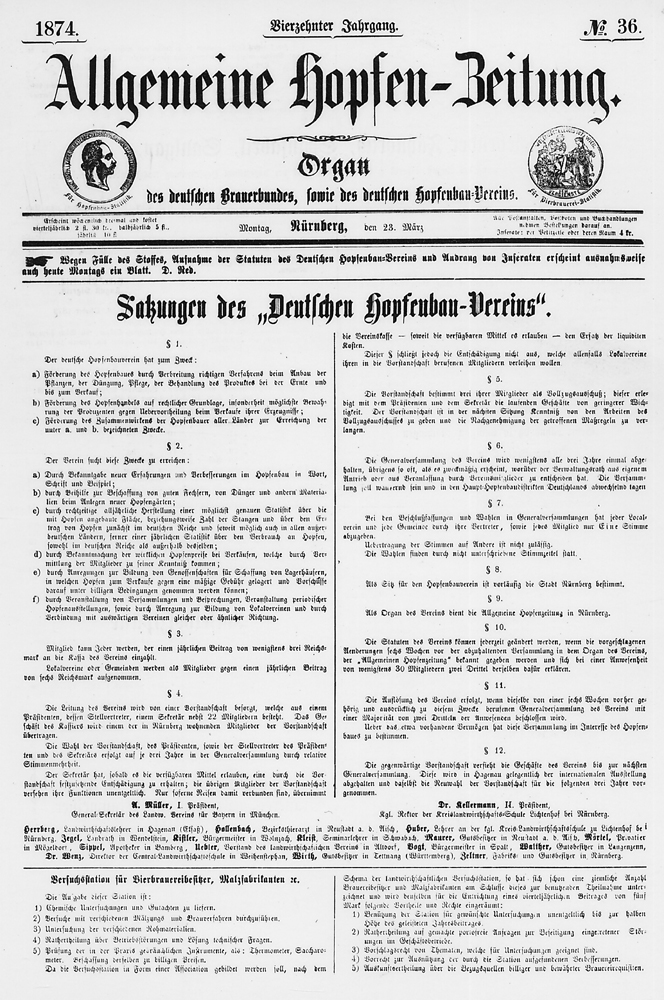
Articles of association of the German Hop-Growing Association, 1874
Since the mid-19th century, hop growing in Germany had experienced a steep rise. Production had multiplied. In some areas, hops grew as far as the eye could see. There were places where every single inhabitant grew hops. Local hop-growing associations had already been formed everywhere. But a national interest group was lacking. The farmers, the maltsters, the brewers, the brewery staff, they all already had something like that. But not the hop world. And not entirely by chance. Because there were plenty of doubters. For them, such a hop association was nothing more than a kind of Trojan horse of the powerful hop traders – and the government. One of the most important tasks of the hop associations was to supply the market with information, statistical information. Where did how much grow, how much was harvested, how many growers were active, things like that. In the hop business, where everything was the free play of forces, where everything was based solely on supply and demand, these were crucial levers for being able to take the right action at the right time in the hop market. However, many growers had no interest in this. They did not like having their cards looked at. Not at all.
That is why they were not very interested in what a few important gentlemen had decided and founded there in the Franconian metropolis. The hop practitioners had nothing to do with the directors, officials and secretaries of the association there. And they certainly didn’t want to report figures to them. One consequence of this inherent mistrust was that until at least the end of the 19th century it was not possible to say exactly how much hops were actually grown in the Hallertau. The various statistics sometimes contradict each other considerably – and this was not due to the carelessness of the people collecting the figures.
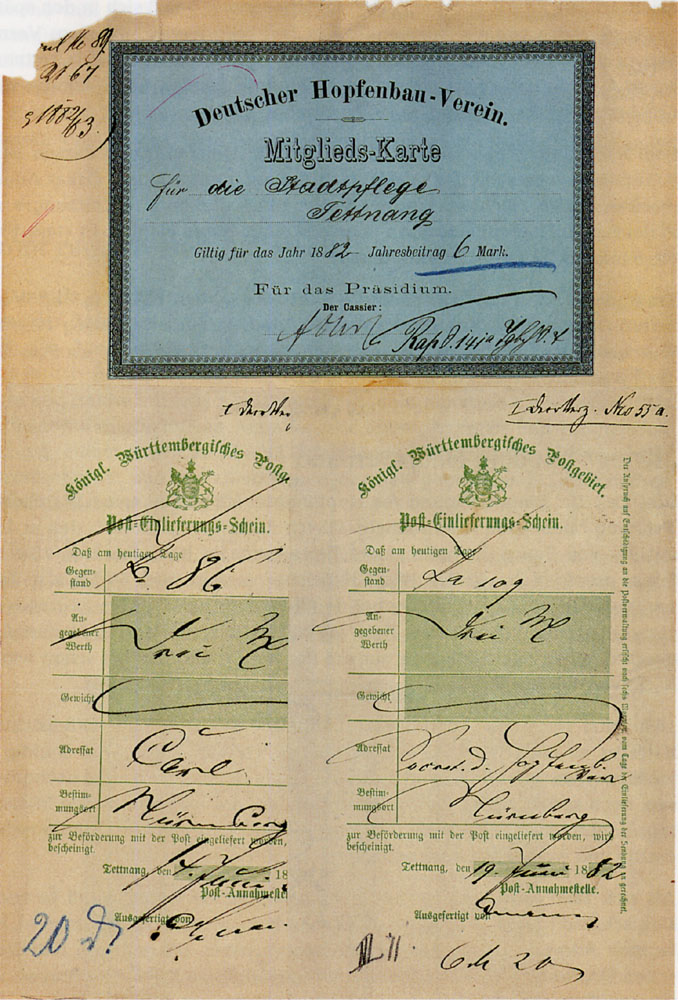
Membership card for the German Hop-Growing Association, 1882. The normal annual membership fee was six marks, three marks for producers (from: Peter Heidtmann: Grünes Gold, 1994)
This did not change much in the following years either. The new hop growers’ association was forced to limit itself to organizing meetings and exhibitions and tried to take a closer scientific look at the cultivation and growth of hop plants.
When the golden years of the hop boom came to an end in 1889, the Nuremberg association officials were met with increasingly loud criticism. They were said to be nothing more than the hop merchants’ stooges and not based in Nuremberg, the world center of the hop trade, by coincidence. That was the line of argument they had to listen to. In 1892, there was a logical repositioning, re-election and reorientation. From Alsace to Posen – all still part of the German Empire at the time – branch associations were formed, which, now much closer to the respective hop-growing areas, endeavored to accommodate the various local interests under one umbrella of opinion more than before. The association also wanted to focus more on issues of cultivation techniques and less on the marketing of hops.
Despite all the restructuring, it was still mainly the more influential hop growers who were involved in the association. They were accustomed to making demands and getting their own way. The smaller growers had no say. When the Hallertau became Germany’s largest hop-growing region in 1912, the opinion of the officials in Nuremberg, who were far away, counted for less and less. And so, after the First World War, there was not much left of the German Hop-Growing Association except a pile of debts and an outdated board of directors.
So in 1923, it was reorganized again. Middle Franconia was finally out of the club business, and the headquarters were moved to Munich. The whole of Germany was only in the name. The president had to come from Bavaria according to the statutes, his deputy from Württemberg, where important hop centers were still located in Tettnang and Rottenburg. All other German areas no longer had much to report in German hop growing. The Bavarian Chamber of Agriculture took over the management. The association also took a completely different approach. It developed from a hop-growing association into a fighting federation. First of all, it tried to influence all hop farmers, more or less forcefully, to join. Whether brewers, hop traders or the Ministry of Agriculture, opponents were seen everywhere, all of whom wanted to dispute the success in the hop business to which the hop farmers were entitled. Even the newly founded hop research institute in Hüll near Wolnzach in 1926 was opposed – which ultimately led to the resignation of the association’s board. And to a further restructuring. From 1928, the association was now called the „Deutscher Hopfenbau-Verband“ (German Hop-Growing Association) and was only to serve as an umbrella organization for the various local associations. Individual hop farmers could now only become members of the 28 branch associations and 380 local groups. However, from now on they were forced to do so. As a result, the German Hop-Growing Association was able to register an impressive 14,800 members in 1929. Every grower who brought hops to be weighed locally automatically paid the membership fee for the respective local association with his weighing fee. No appeal was possible.
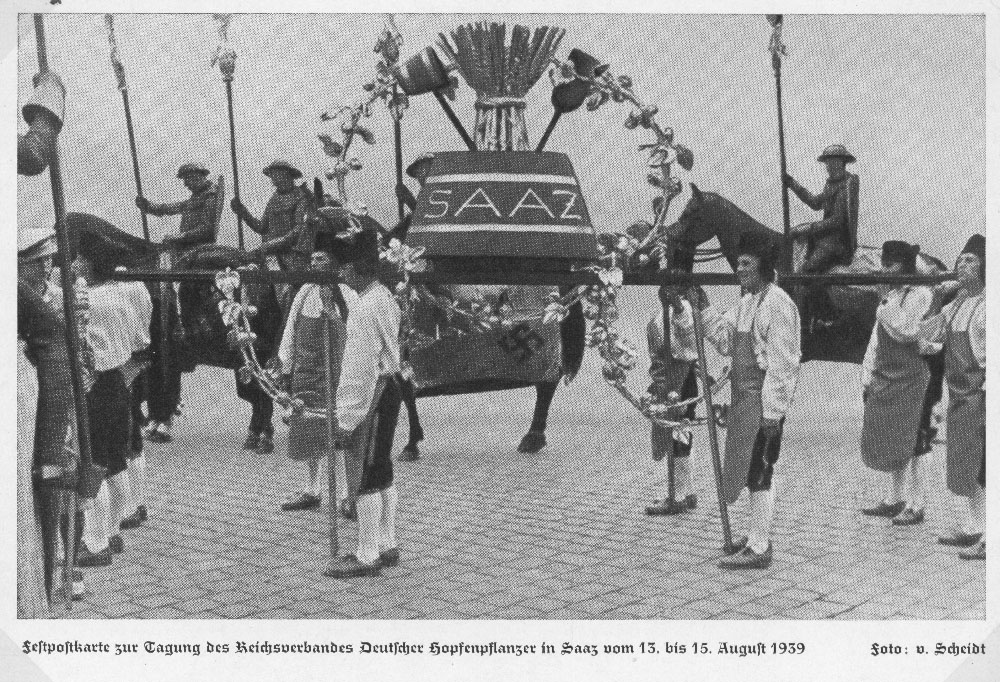
Festive postcard for the conference of the Reich Association of German Hop Growers in Saaz from August 13 to 15, 1939
Perhaps this was a first taste of what was to come in the following years. With the rise to power of the National Socialist regime in 1933, the history of the independent German Hop Growers’ Association/Federation came to an end for the time being. It was forcibly incorporated into the state-run Reichsnährstand (Nazi farmers’ organization). So-called “hop growers‘ guilds” continued to exist, and in 1937 their designation was changed back to “associations”, for example the “Hop Growers’ Association Hallertau” from 1938. In 1938, the National Socialist government merged all the regional associations into the “Reich Association of German Hop Growers”. In the meantime, the hop-growing areas in the Austrian Mühlviertel, Bohemia and, as the war progressed, the occupied territories in Alsace and Slovenia had also joined. The association’s task was to implement all measures ordered by the state authorities in the growing areas. These included the exact regulation of the acreage, which prescribed for each hop farmer exactly how many hop plants he was allowed to grow – indicated for all to see by a metal sign in the hop garden. Where this was not adhered to, compulsory grubbing-up was carried out. This was also one of the tasks of the planters’ association. In 1944, the office was relocated to Roth near Nuremberg, which was less at risk from bombing, due to the war.
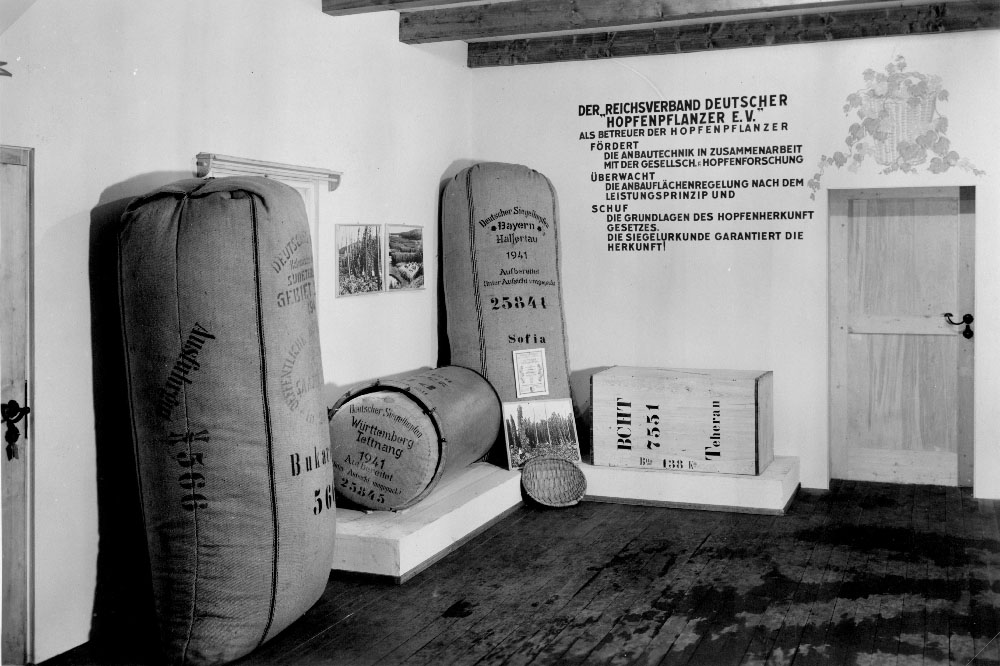
Hop exhibition of the Reichsverband Deutscher Hopfenpflanzer, 1941
After the war, the new “Association of Bavarian Hop Growers” initially took over the business of the old Reich Association. After several years of restructuring, the new German Hop Growers’ Association was finally able to commence its work in 1949 as the umbrella organization for all German hop growers. The Hallertau Hop Growers’ Association had already been established two years earlier. And now, at last, the association was active where the hops actually came from, from the largest hop-growing area in Germany, from Wolnzach.
Since then, the two associations have been conducting their beneficial activities in the German and Hallertau hop worlds from there. “The association life of the German and Hallertau hop grower organizations has been (…) in calm continuity since the reestablishment (…),” wrote association chronicler Lorenz Kettner on the occasion of the 1974 anniversary. After so much historical turmoil, this is absolutely understandable. Nevertheless, the 100th anniversary was celebrated in style, with a 100-page chronicle, a ceremony in Munich’s Cuvillies Theater and in the Haus der Kunst (with more than 100 guests), a beer menu with 100 different beers (from all over Germany), Käfer’s Party Sound (for dancing) and everything else that went with it. Perhaps people were in a more celebratory mood back then. Or perhaps people first have to learn about the exact background of the association’s history, which Kettner compiled in his scientifically researched chronicle.
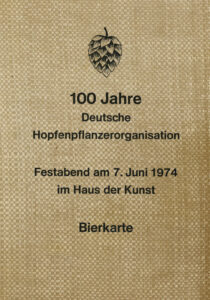
Beer menu from the 100th anniversary celebration

Guest card for the 100th anniversary celebration, 1974
In any case, the 150th anniversary in 2024 passed completely unnoticed by the growers’ association and the rest of the hop family. What once began in Nuremberg is now too far removed from today’s organization. In 25 years, however, it won’t be so easy to get away with it when another centenary is on the agenda. But then for real. With at least 175 beers. From all over the world.
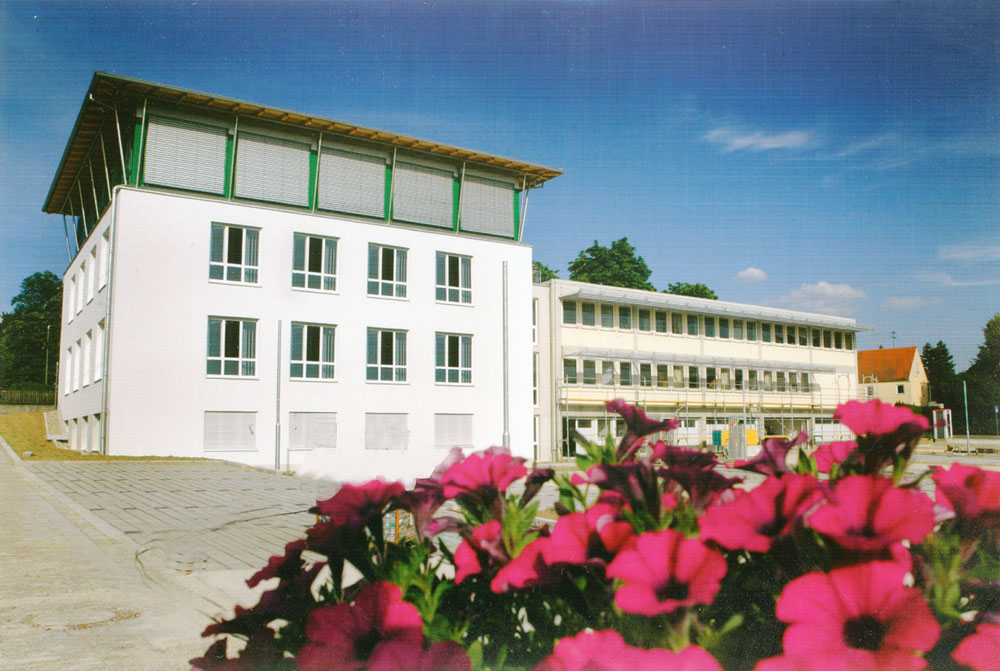
The “House of Hops” with new extension, 2003